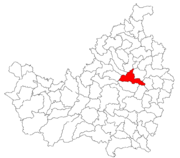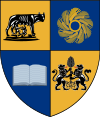Bonțida
Bonțida | |
|---|---|
Commune | |
 The Bánffy Castle | |
 Location of the settlement on Cluj County map | |
| Coordinates: 46°54′N 23°48′E / 46.900°N 23.800°E | |
| Country | |
| County | Cluj County |
| Status | Commune |
| Settled | 1263 |
| Commune seat | Bonțida |
| Villages | Bonțida, Coasta, Răscruci, Tăușeni |
| Government | |
| • Mayor | Emil Cărhaț (PNL) |
| Area | |
| • Total | 80.38 km2 (31.03 sq mi) |
| Population (2011)[1] | |
| • Total | 4,856 |
| • Density | 60/km2 (160/sq mi) |
| Time zone | UTC+2 (EET) |
| • Summer (DST) | UTC+3 (EEST) |
| Area code | +40 x64[2] |
| Website | http://www.comunabontida.ro |
Bonțida (Romanian pronunciation: [bonˈt͡sida]; Hungarian: Bonchida, pronounced [ˈbont͡shidɒ], transl. "Bonc's bridge"; German: Bonisbruck) is a commune in Cluj County, Romania. It is known as the home of a Baroque castle owned by the Bánffy family (of which Miklós Bánffy was a member); partly destroyed during World War II and neglected by the communist regime in Romania, it is currently being restored.
The Bánffy family had another castle in Răscruci, which is part of Bonțida and also the birthplace of poet Albert Wass. The Răscruci castle features in the reminiscences of an English governess, Florence Tarring, who worked for one of the branches of the Bánffy family during the First World War (1914-1919).[3]
The commune is composed of four villages: Bonțida, Coasta (Gyulatelke), Răscruci (Válaszút) and Tăușeni (Marokháza).
Demographics
According to the census from 2002 there was a total population of 4,722 people living in this town. Of this population, 65.07% are ethnic Romanians, 19.10% are ethnic Hungarians and 15.75% ethnic Romani.[4]
Natives
See also
References
- ^ Template:Ro icon Populația stabilă după etnie - județe, municipii, orașe, comune, National Institute of Statistics; accessed January 14, 2016
- ^ x is a digit indicating the operator: 2 for the former national operator, Romtelecom, and 3 for the other ground telephone networks
- ^ Florence Tarring (2010). Elizabeth Watson (ed.). Miss Tarring's War. ISBN 978-1-921586-20-0.
- ^ http://www.edrc.ro/recensamant.jsp?regiune_id=2140&judet_id=2295&localitate_id=2311


